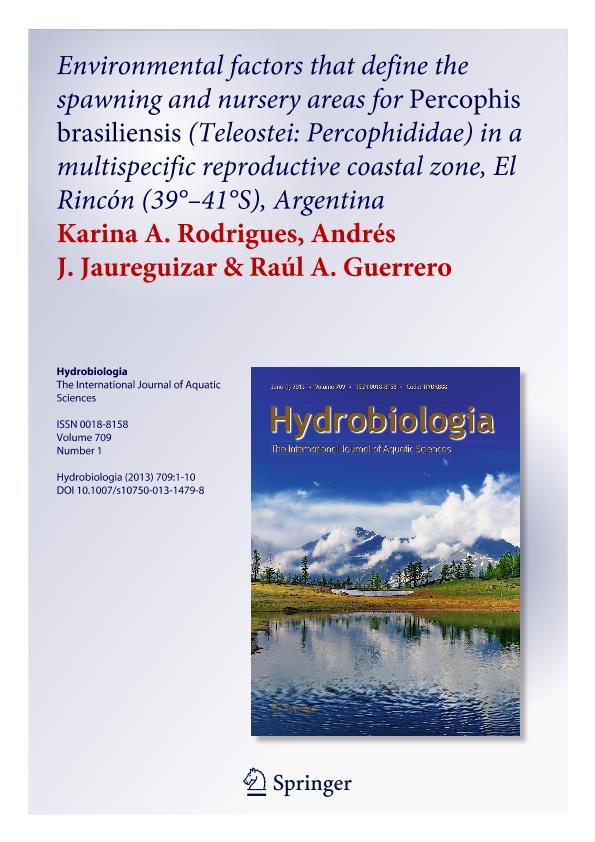Mostrar el registro sencillo del ítem
dc.contributor.author
Rodrigues, Karina Andrea

dc.contributor.author
Jaureguizar, Andrés Javier

dc.contributor.author
Guerrero, Raul Alfredo

dc.date.available
2017-09-27T20:10:09Z
dc.date.issued
2013-06
dc.identifier.citation
Rodrigues, Karina Andrea; Jaureguizar, Andrés Javier; Guerrero, Raul Alfredo; Environmental factors that define the spawning and nursery areas for Percophis brasiliensis (Teleostei: Percophididae) in a multispecific reproductive coastal zone, El Rincón (39°–41°S), Argentina; Springer; Hydrobiologia; 709; 1; 6-2013; 1-10
dc.identifier.issn
0018-8158
dc.identifier.uri
http://hdl.handle.net/11336/25260
dc.description.abstract
The spatial distribution of Percophis brasiliensis at different maturity stages and its relationship to environmental factors was evaluated in the El Rincon area (39°–41°S) between 1994 and 2008 during eight cruises carried out in spring. For this, a canonical correspondence analysis was used. Results indicate that bottom temperature and bottom salinity horizontal gradient (BSHG) were the most important variables affecting the spatial distribution of P. brasiliensis maturity stages. Juveniles were mainly located in shallow waters with low salinity, high temperatures and vertical stratification. Conversely, gravid and running individuals were found in high BSHG and low temperatures. This link suggests that adults spawn in a well-defined area of hydrographic conditions that would tend to retain pelagic eggs and larvae, thus minimizing dispersal, and ensuring their transport from the spawning to nursery areas. On the coastal shelf of El Rincon, the water mass circulation shows an anti-cyclonic gyre whose recirculation cell during spring and summer is more constrained to inshore areas than during winter. Maximum reproductive activity of P. brasiliensis coincides with the highest retention period; therefore, dispersal of early-life stages (eggs) depends on the circulation pattern and transport pathway which would contribute importantly to its recruitment variability.
dc.format
application/pdf
dc.language.iso
eng
dc.publisher
Springer

dc.rights
info:eu-repo/semantics/openAccess
dc.rights.uri
https://creativecommons.org/licenses/by-nc-sa/2.5/ar/
dc.subject
Percophis Brasiliensis
dc.subject
Maturity Stages
dc.subject
Environmental Influence
dc.subject
Northern Argentine Sea
dc.subject
El Rincón
dc.subject.classification
Bioquímica y Biología Molecular

dc.subject.classification
Ciencias Biológicas

dc.subject.classification
CIENCIAS NATURALES Y EXACTAS

dc.title
Environmental factors that define the spawning and nursery areas for Percophis brasiliensis (Teleostei: Percophididae) in a multispecific reproductive coastal zone, El Rincón (39°–41°S), Argentina
dc.type
info:eu-repo/semantics/article
dc.type
info:ar-repo/semantics/artículo
dc.type
info:eu-repo/semantics/publishedVersion
dc.date.updated
2017-09-25T17:59:59Z
dc.journal.volume
709
dc.journal.number
1
dc.journal.pagination
1-10
dc.journal.pais
Alemania

dc.journal.ciudad
Berlin
dc.description.fil
Fil: Rodrigues, Karina Andrea. Instituto Nacional de Investigaciones y Desarrollo Pesquero; Argentina. Consejo Nacional de Investigaciones Científicas y Técnicas; Argentina
dc.description.fil
Fil: Jaureguizar, Andrés Javier. Instituto Nacional de Investigaciones y Desarrollo Pesquero; Argentina. Provincia de Buenos Aires. Gobernación. Comisión de Investigaciones Científicas; Argentina
dc.description.fil
Fil: Guerrero, Raul Alfredo. Instituto Nacional de Investigaciones y Desarrollo Pesquero; Argentina. Universidad Nacional de Mar del Plata; Argentina
dc.journal.title
Hydrobiologia

dc.relation.alternativeid
info:eu-repo/semantics/altIdentifier/doi/http://dx.doi.org/10.1007/s10750-013-1479-8
dc.relation.alternativeid
info:eu-repo/semantics/altIdentifier/url/https://link.springer.com/article/10.1007/s10750-013-1479-8
Archivos asociados
